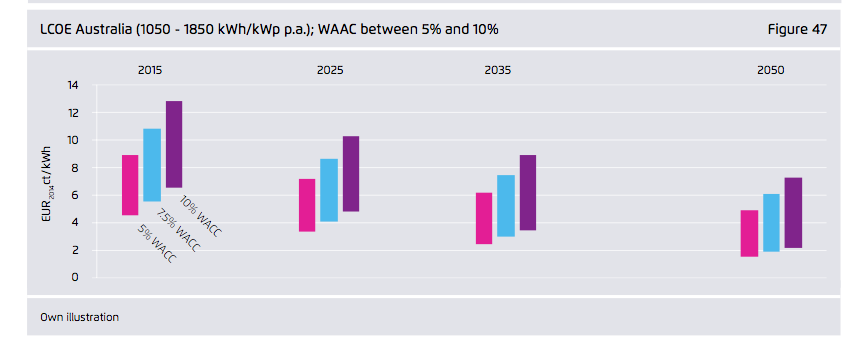Solar PV will be the cheapest form of power within a decade, and cost less than $US0.02/kWh by 2050, a major German study has predicted.
The study, by Berlin-based think tank Agora Energiewende, says that the end to cost reductions from solar plants is “not in sight”, even after falling more than 80 per cent in recent years.
This was primarily due to a doubling in module efficiency, the report said, which would mean less panels were needed to produce the same amount of power, and therefore less land, less materials, less maintenance and lower installation costs.
The think tank predicts that balance of systems costs will fall by up to two-thirds in coming decades and, combined with a fall in the cost of finance, could cut the cost of solar technology in areas such as Australia, the US and parts of Europe to as low as 1.5 Euro cents/kWh.
“Even in the most conservative scenarios for market development, without considering technology breakthroughs, significant further cost reductions are expected,” the report says.
The forecasts produce a range of outcomes, depending on the actual increase in module efficiency – to 24, 30, or 35 per cent; the scale of deployment in coming decades, and the extent of “learning rates”.
Finally, depending on annual sunshine, power costs of Euro 4-6 c/kWh are expected in Europe by 2025, reaching Euro 2-4 c/kWh by 2050. That means it will be cheaper than conventional technologies – which costs between Euro 5c and 10c/kWh – by 2025.
It will even cheaper – at Euro 1.5c/kWh – in countries with more sun.
“For the next decade, this represents a cost reduction of roughly one-third below the 2015 level,” it says. “In the long term, a reduction of roughly two-thirds compared to the current cost is expected.”
Lead author Daniel Fuerstenwerth said one of the reasons for the study was the lack of recognition among policy makers and advisors about future cost falls in solar PV, and official forecasts which continued to downplay the potential role of the technology.
“The long-term scenarios tend to underestimate the role of solar in power systems and in decarbonisation efforts,” Fuerstenwerth told RenewEconomy in a phone interview.
“When you look at the scenarios being prepared – there is always a very small share of solar. For example, in Germany, the power grid system is being discussed for scenarios that include a maximum 10 per cent share of solar PV in long term future.”
The Agora study found that in “large parts” of Europe, large scale solar was likely to be competing with conventional technologies – which costs between Euro 5c and 10c/kWh – by 2025.
In other regions of the world with higher solar irradiation, solar power will be even cheaper than in Europe.
“Our results indicate that solar power will become the cheapest source of electricity in many regions of the world, reaching costs of between Euro 1.6 and 3.7c/kWh in India and the Mena region (Middle East and North Africa) by 2050.
In Australia, the study says, costs will reach Euro 3.4 to 7.1c/kWh in 2025 and 1.6 to 4.9 c/kWh in 2050. Interestingly, the study underlines how the cost of capital will be critical to the cost of electricity delivered by solar. This graph below illustrates how (remember the currency is in Euro).
© 2015 Solar Choice Pty Ltd

colour me naïve but why isn’t this stuff in main stream media-yes im serious